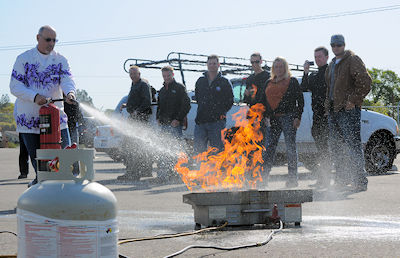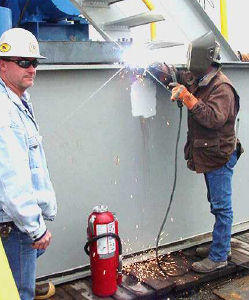Section 9 - Fire Prevention and Protection
09.A General.
09.A.01 A fire prevention plan must be developed for all USACE facilities and project sites. For Construction operations see NFPA 241; for Marine operations see Section 19.A.04.

- It must include, as a minimum: A list of the major workplace fire hazards; potential ignition sources; the types of fire suppression equipment or systems appropriate to the control of fire; assignments of responsibilities for maintaining the equipment and systems; personnel responsible for controlling the fuel source hazards; and housekeeping procedures, including the removal of waste materials.
- It must be used to brief employees and emergency first responders on the fire hazards, the materials and processes to which they are exposed, and the emergency evacuation procedures.
09.A.02 An annual survey of the suitability and effectiveness of fire prevention and protection measures and facilities at each project or installation must be made by a qualified person. Records of the survey findings and recommendations must be retained on file at the project or installation.
09.A.03 When unusual fire hazards exist or fire emergencies develop, additional protection must be provided as required by the GDA.
09.A.04 The GDA must survey all activities and determine which require a hot work permit. All hot work and hot work permits must conform to local policy, when present.

- Hot work permits must be required when performing activities which generate or have the potential to generate, heat, sparks, or open flames, such as abrasive blasting, burning, brazing, cutting, grinding, powder-actuated tools, hot riveting, soldering, thawing activities, welding, or any similar operation capable of initiating fires or explosions.
- Areas must be surveyed prior to performing any hot work to ensure they are free of fire hazards and to determine if a fire watch is required.
- Fire watches must be conducted in accordance with Sections 09.K.01 and 09.K.03.
- A fully charged fire extinguisher, minimum 10 lbs, must be readily available in the immediate area of the hot work.
- Hot work permits must include date(s) authorized for hot work and identify the objects on which the hot work is to be performed. The permit must be kept on file until the completion of the hot work.
- Hot work is prohibited in the following areas:
- In areas not authorized by GDA;
- In sprinklered buildings while such protection is impaired, unless equivalent protection is provided for the hot work and approved by the GDA;
- In the presence of explosive atmospheres, areas where an explosive atmosphere may develop, or where there is an accumulation of combustible dust;
- In area near the storage of large quantities of exposed, readily ignitable materials such as bulk sulfur, baled paper, or cotton.
- See NFPA 51B, Fire Prevention During Welding, Cutting, and Other Hot Work for a sample hot work permit and further information. See also Sections 09.E and 10.D.
09.A.05 Fires and open flame devices must not be left unattended.
09.A.06 All sources of ignition must be prohibited within 50 ft (15.2 m) of operations with a potential fire hazard. The area must be conspicuously and legibly posted "NO SMOKING, MATCHES, or OPEN FLAME."
09.A.07 Smoking must be prohibited in all areas where flammable, combustible, or oxidizing materials are stored. "NO SMOKING, MATCHES, or OPEN FLAME" signs will be posted in all prohibited areas.
09.A.08 Areas where there is danger of underground fire must not be used for the storage of flammable or combustible materials.
09.A.09 A barrier having a fire resistance rating equivalent to a listing of at least 1 hour must segregate DOT-identified noncompatible materials that may create a fire hazard. > See Section 20.D for compressed gas cylinders.
09.A.10 A good housekeeping program that provides for prompt removal and disposal of accumulations of combustible scrap and debris must be implemented on the site. Self- closing containers must be used to collect waste saturated with flammable liquids. Only non-combustible or UL labeled nonmetallic containers may be used to dispose of waste and rubbish.
09.A.11 Measures must be taken to control the growth of tall grass, brush, and weeds adjacent to facilities. A break of at least 3 ft (0.9 m) must be maintained around all facilities.
09.A.12 Paint-soiled clothing and drop cloths, when not in use, must be stored in well- ventilated steel cabinets or containers.
09.A.13 Disposal of combustible waste materials must be in compliance with applicable fire and environmental laws and regulations.
Knowledge Check Choose the best answer for the question.
9-1. All sources of ignition must be prohibited within _____ of operations with a potential fire hazard?
You forgot to answer the question!
